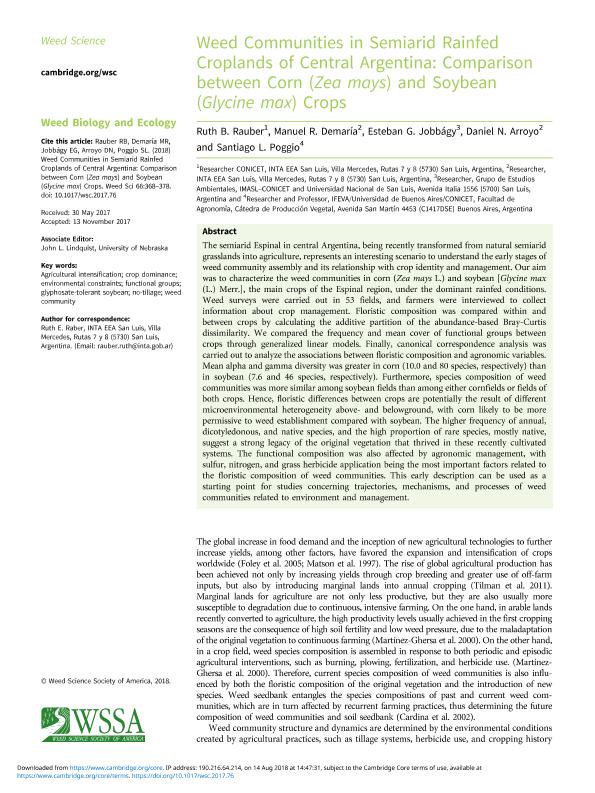Mostrar el registro sencillo del ítem
dc.contributor.author
Rauber, Ruth Bibiana

dc.contributor.author
Demaría, Manuel R.
dc.contributor.author
Jobbagy Gampel, Esteban Gabriel

dc.contributor.author
Arroyo, Daniel N.
dc.contributor.author
Poggio, Santiago Luis

dc.date.available
2020-01-08T20:28:00Z
dc.date.issued
2018-05
dc.identifier.citation
Rauber, Ruth Bibiana; Demaría, Manuel R.; Jobbagy Gampel, Esteban Gabriel; Arroyo, Daniel N.; Poggio, Santiago Luis; Weed Communities in Semiarid Rainfed Croplands of Central Argentina: Comparison between Corn (Zea mays) and Soybean (Glycine max) Crops; Weed Science Society of America; Weed Science; 66; 3; 5-2018; 368-378
dc.identifier.issn
0043-1745
dc.identifier.uri
http://hdl.handle.net/11336/94013
dc.description.abstract
The semiarid Espinal in central Argentina, being recently transformed from natural semiarid grasslands into agriculture, represents an interesting scenario to understand the early stages of weed community assembly and its relationship with crop identity and management. Our aim was to characterize the weed communities in corn (Zea mays L.) and soybean [Glycine max (L.) Merr.], the main crops of the Espinal region, under the dominant rainfed conditions. Weed surveys were carried out in 53 fields, and farmers were interviewed to collect information about crop management. Floristic composition was compared within and between crops by calculating the additive partition of the abundance-based Bray-Curtis dissimilarity. We compared the frequency and mean cover of functional groups between crops through generalized linear models. Finally, canonical correspondence analysis was carried out to analyze the associations between floristic composition and agronomic variables. Mean alpha and gamma diversity was greater in corn (10.0 and 80 species, respectively) than in soybean (7.6 and 46 species, respectively). Furthermore, species composition of weed communities was more similar among soybean fields than among either cornfields or fields of both crops. Hence, floristic differences between crops are potentially the result of different microenvironmental heterogeneity above- and belowground, with corn likely to be more permissive to weed establishment compared with soybean. The higher frequency of annual, dicotyledonous, and native species, and the high proportion of rare species, mostly native, suggest a strong legacy of the original vegetation that thrived in these recently cultivated systems. The functional composition was also affected by agronomic management, with sulfur, nitrogen, and grass herbicide application being the most important factors related to the floristic composition of weed communities. This early description can be used as a starting point for studies concerning trajectories, mechanisms, and processes of weed communities related to environment and management.
dc.format
application/pdf
dc.language.iso
eng
dc.publisher
Weed Science Society of America

dc.rights
info:eu-repo/semantics/openAccess
dc.rights.uri
https://creativecommons.org/licenses/by-nc-sa/2.5/ar/
dc.subject
AGRICULTURAL INTENSIFICATION
dc.subject
CROP DOMINANCE
dc.subject
ENVIRONMENTAL CONSTRAINTS
dc.subject
FUNCTIONAL GROUPS
dc.subject
GLYPHOSATE-TOLERANT SOYBEAN
dc.subject
NO-TILLAGE
dc.subject
WEED COMMUNITY
dc.subject.classification
Agricultura

dc.subject.classification
Agricultura, Silvicultura y Pesca

dc.subject.classification
CIENCIAS AGRÍCOLAS

dc.title
Weed Communities in Semiarid Rainfed Croplands of Central Argentina: Comparison between Corn (Zea mays) and Soybean (Glycine max) Crops
dc.type
info:eu-repo/semantics/article
dc.type
info:ar-repo/semantics/artículo
dc.type
info:eu-repo/semantics/publishedVersion
dc.date.updated
2019-10-23T21:07:02Z
dc.journal.volume
66
dc.journal.number
3
dc.journal.pagination
368-378
dc.journal.pais
Estados Unidos

dc.journal.ciudad
Lawrence
dc.description.fil
Fil: Rauber, Ruth Bibiana. Instituto Nacional de Tecnología Agropecuaria; Argentina. Consejo Nacional de Investigaciones Científicas y Técnicas; Argentina
dc.description.fil
Fil: Demaría, Manuel R.. Instituto Nacional de Tecnología Agropecuaria; Argentina
dc.description.fil
Fil: Jobbagy Gampel, Esteban Gabriel. Consejo Nacional de Investigaciones Científicas y Técnicas. Centro Científico Tecnológico Conicet - San Luis. Instituto de Matemática Aplicada de San Luis "Prof. Ezio Marchi". Universidad Nacional de San Luis. Facultad de Ciencias Físico, Matemáticas y Naturales. Instituto de Matemática Aplicada de San Luis "Prof. Ezio Marchi"; Argentina
dc.description.fil
Fil: Arroyo, Daniel N.. Instituto Nacional de Tecnología Agropecuaria; Argentina
dc.description.fil
Fil: Poggio, Santiago Luis. Consejo Nacional de Investigaciones Científicas y Técnicas. Oficina de Coordinación Administrativa Parque Centenario. Instituto de Investigaciones Fisiológicas y Ecológicas Vinculadas a la Agricultura. Universidad de Buenos Aires. Facultad de Agronomía. Instituto de Investigaciones Fisiológicas y Ecológicas Vinculadas a la Agricultura; Argentina
dc.journal.title
Weed Science

dc.relation.alternativeid
info:eu-repo/semantics/altIdentifier/url/https://www.cambridge.org/core/product/identifier/S0043174517000765/type/journal_article
dc.relation.alternativeid
info:eu-repo/semantics/altIdentifier/doi/http://dx.doi.org/10.1017/wsc.2017.76
Archivos asociados
